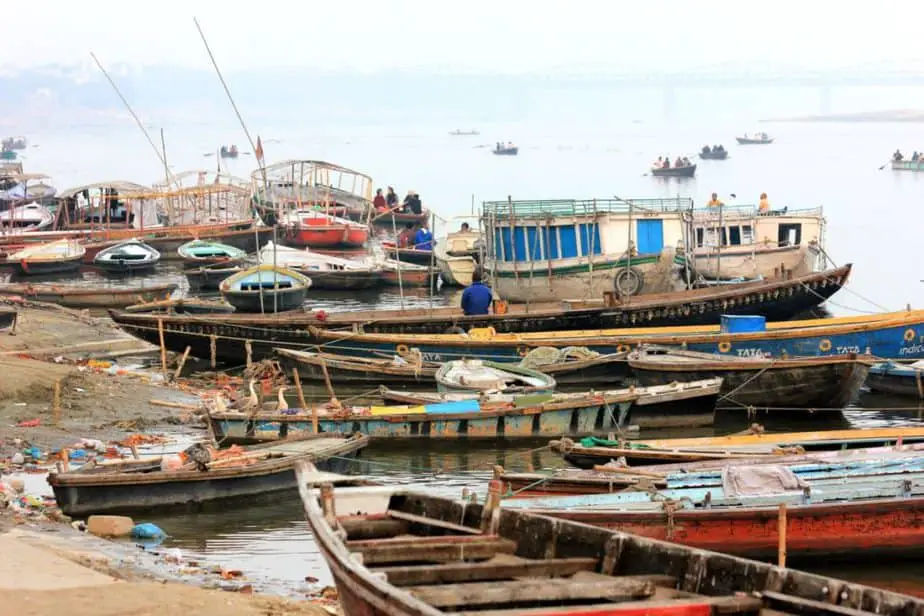If you’re planning a trip to Kerala’s Backwaters, you have a lot to look forward to. But if you’re taking a houseboat trip you may be wondering if you can swim in waters, like I was…
The water in the Kerala backwaters is not suitable for swimming. 230,160 liters of wastewater reaches the largest lake in the Backwaters each day. Plus, 26.9% of water sources in Kerala are completely polluted and 46.1% are partly polluted, according to the Fauna Journal.

However, it is safe to take a houseboat trip in the backwaters and there have been tours going through those peaceful idyllic waters for over 600 years. I took one recently with family and it was a wonderful experience.
You will just want to swim in places besides the Backwaters and in this post, I’ll share more details about the pollution in the waters as well as how you can go swimming on your Kerala vacation.
How Polluted Are Kerala’s Backwaters?

Kerala’s was ranked as one of the “50 Destinations of a Lifetime” by National Geographic Traveler and the backwaters are the main attraction.
Kerala’s Backwaters are an ecosystem of brackish (freshwater mixed with seawater) lagoons, lying next to the Arabian Sea. There are 10 large rivers heading north and south. There are 35 smaller rivers coming from the nearby mountains.
The area is similar to the bayous in Louisiana in the United States.
Vembanad Lake is the huge lake in the center of the backwaters. It is 785 square miles (2,033 sq km) and extends to a large network of rivers, canals and waterways that stretch for over 560 miles (900 km).
The Vembanad wetland is the largest wetland system in India, and the local people rely on it to make a living.
180,000 tourists visit the area each year and about 200 houseboats operate on the lake. But there are more than 1,200 houseboats in operation on the backwaters.
The houseboats, also called kettuvallams, were once barges used to haul rice. They had a roof to keep the rice dry and were often 100 feet in length. During British rule, the boats were converted to living spaces for royalty.
Then they were further converted for foreign and domestic tourists. They are now floating cottages with a bedroom, a western-style toilet, a place to dine, and a porch to enjoy the views as you slowly drift through the scenic waterways.
Meals are cooked by the on-board staff and tourists hire the boats for a few hours to a week.
Domestic tourists tend to prefer fast motorboats and to use the time to party. While foreign tourists tend to prefer non-motorized boats and to enjoy the peace and quite.
With the large number of houseboats (only 507 houseboats are officially registered) and so many tourists in the area, this had led to a lot of pollution ending up in the lake and the surrounding waters.
According to the Fauna Journal, there is an overcrowding of houseboats which is negatively impacting the ecosystem and water quality.
- 230,160 liters of wastewater end up in Vembanad Lake each day
- 260,000 million liters of trade effluents (liquid waste) reach the lake from the industrial areas of Kerala
- Faecal coliform count is up to 1800/100 ml in the lake. Swimming beaches should NOT exceed 88/100 ml, according to the New Hampshire Department of Environmental Services
- 187 tons of solid waste reach the lake
Another Study Report on Status of Water Resource in Kerala looked at 3606 water sources in the region. 1302 ponds, 1107 public wells, 941 canals, 153 rivers areas, 16 backwater stretches, and 87 other sources were analyzed for pollution.
The study found that:
- 26.9% of water sources were completely polluted
- 46.1% of water sources were partly polluted
- 27% of water sources were unpolluted
- Solid waste was found in 53% of polluted water sources
- Liquid waste was found in 16.97% of polluted water sources
- Household waste was found in 23.24% of polluted water sources
- Encroachment was found in 7% of polluted water sources (meaning roads, railroads, utilities, and other developments infiltrate the water sources)
While the study doesn’t exclusively test Kerala’s Backwaters, the water sources are interconnected with the extensive waterways.
With such conclusive evidence for pollution in the Kerala Backwaters, it would be risky to go swimming in them.
Other Reasons to Avoid Swimming in Kerala’s Backwaters

As you cruise up the rivers and canals, you will see that many locals live along the waterways and use the water for many purposes:
- Bathing
- Fishing with large nets
- Washing clothes
There are also nearby rice patty fields that use pesticides that can run off into the waterways. High levels of metals have been detected in the waters.
In addition, the waters are swampy and the fast-growing weed, water hyacinth covers many of the canals. The plant is becoming a problem and taking oxygen from fish, getting tangled in fishing nets, and damaging boat propellers. Plus, it’s where mosquitos breed.
Overall, while it may be hot on your trip, you’d want to avoid cooling off in Kerala’s Backwaters.
Although I do NOT recommend swimming in the Backwaters, I do see that some travelers did take a swim in the waters:
Are There Crocodiles in Kerala’s Backwaters?

There are no recorded cases of crocodile attacks nor evidence that crocodiles live in Kerala’s Backwaters.
Before the 1940’s saltwater crocodiles did live in many parts of Southeast Asia, the Eastern coast of India and as far northwest as Kochi.
However, saltwater crocodiles were vigorously hunted until they were extinct in the area.
The mangrove habitats where the saltwater crocodiles lived were also destroyed, helping to further their extinction from the area, according to a paper Mangroves of Kerala.
However, there is evidence that Mugger crocodiles live in the state of Kerala, although no attacks have been recorded in Kerala’s Backwaters.
There have been a dozen crocodile attacks 55 miles (89 km) south of Kollam, one of Kerala’s southernmost hubs for the backwaters.
Neyyar Wildlife Sanctuary houses a number of mugger crocodiles and the attacks happened in the surrounding area.
There was a death of a 57-year-old woman near the Sanctuary, according to Gulf News.
Another attack was recorded near the Chalakudy River in 2012, which is the fifth largest river in Kerala and located north of the Backwaters.
In Thiruvananathapuram, a mugger crocodile was found in a home after a large flood, yet no injuries occurred.
However, according to CrocBite, an online research project recording crocodile attacks, there were 58 crocodile attacks in India in 2019, and none of them were in Kerala.
Given this data, your odds of meeting a crocodile seem very low.
What Are the Best Places for Swimming Near Kerala’s Backwaters?

If you want to go swimming on your trip to Kerala’s Backwaters, the ocean is close and there are plenty of resorts with swimming pools.
However, if you want to go to the beach, you will have to be wary of the dangerous undertows in the ocean. In other places, the waters get deep very quickly and there are rough seas, so please EXERCISE CAUTION and use your own discretion when selecting swimming spots.
There are a number of beaches and resorts you can swim at though:
Somatheeram Beach
This is one of the most popular beach resorts in Kerala and was the first Ayurvedic resort in India. There is a beautiful beach and once you are finished swimming, you can get a relaxing Ayurvedic massage.
Marari Beach
Marari Beach doesn’t have a lot of restaurants or nightlife, but there is a relaxing secluded beach that is safe for swimming. It’s perfect for families.
Kovalam’s Beaches
There are two beaches in Kovalam. Eve’s Beach and Lighthouse Beach are both great for swimming. You can also find diving, Ayurvedic massages, bars, and restaurants.
Payyambalam
Payyambalam is not far from Kannur and has miles of beautiful beaches that are safe for swimming. There are a small number of restaurants and cafes for drinks in the area.
Ashtamudi Lake Resorts
The backwaters near Ashtamudi Lake are some of the largest in Kerala and the 10-mile-long lake (16 km) is the home to many luxury resorts.
Similar to the Maldives, there are floating cabanas you can rent, giving you a lakeside view from your front porch.
There are many luxury resorts with gorgeous swimming pools that are the perfect place to cool down after a day on the boat.
Summary:
If you were hoping to go swimming in Kerala’s Backwaters, the risks are too high to advise it. However, there are a number of safe places to swim at the Arabian Sea nearby or the swimming pools in the resorts.
If you’re traveling in India, one question I get alot is: Should I buy travel insurance for India or not? In this +3,000-word-article I share everything you need to know about travel insurance for your trip.
Related Articles:


